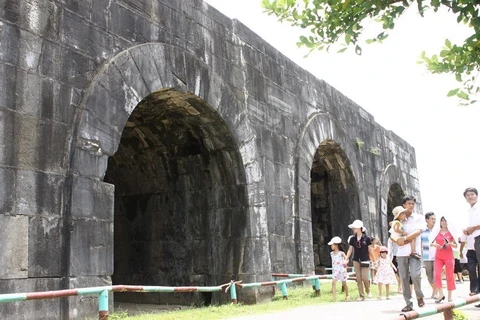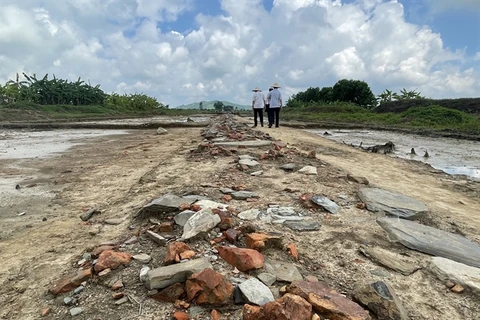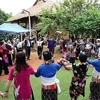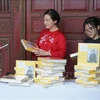Thanh Hoa (VNA) – UNESCO Representative in Vietnam Christian Manhart recognised efforts by authorities of central Thanh Hoa province and experts to study and excavate the Citadel of the Ho Dynasty, while meeting with the preservation centre for this world cultural heritage site on January 9.
He recommended the centre continue documenting the study and excavation of the site, located in Vinh Loc district, and apply non-invasive scanning technique to improve excavation effectiveness.
Manhart said the Citadel of the Ho Dynasty (1400 - 1407) holds architectural and landscape values that were the greatest and most unique of its kind in East Asia and Southeast Asia in the late 14th and early 15th centuries.
 UNESCO Representative in Vietnam Christian Manhart (third from right) visits the Citadel of the Ho Dynasty on January 9. (Photo: VNA) Assoc. Prof. and Dr Tong Trung Tin, Chairman of the Vietnam Archaeology Association, said since 2020, archaeologists and scientists have conducted relatively large excavations of the citadel. Notably, a dig on 25,000 sq.m. in the inner part of the citadel discovered four clusters of vestiges dating back to the Tran (1225 - 1400) - Ho dynasties, two to the Le So Dynasty (1428 - 1527), and one to the Le Trung Hung Dynasty (1533 - 1789).
UNESCO Representative in Vietnam Christian Manhart (third from right) visits the Citadel of the Ho Dynasty on January 9. (Photo: VNA) Assoc. Prof. and Dr Tong Trung Tin, Chairman of the Vietnam Archaeology Association, said since 2020, archaeologists and scientists have conducted relatively large excavations of the citadel. Notably, a dig on 25,000 sq.m. in the inner part of the citadel discovered four clusters of vestiges dating back to the Tran (1225 - 1400) - Ho dynasties, two to the Le So Dynasty (1428 - 1527), and one to the Le Trung Hung Dynasty (1533 - 1789).
These are important evidences of the integrity, authenticity, and globally outstanding values of the citadel, he noted, adding that the archaeological findings will be a trustworthy source for restoring part of the heritage.
They also demonstrate local authorities and people’s efforts to implement the International Council on Monuments and Sites’ recommendations about heritage value preservation and promotion as in line with the 1972 UNESCO World Heritage Convention, Tin added.
The same day, Director of the Thanh Hoa provincial Department of Culture, Sports and Tourism Pham Nguyen Hong had a working session with UNESCO Representative Christian Manhart, calling for the UNESCO Office’s assistance for the preservation and promotion of the citadel’s values./.
He recommended the centre continue documenting the study and excavation of the site, located in Vinh Loc district, and apply non-invasive scanning technique to improve excavation effectiveness.
Manhart said the Citadel of the Ho Dynasty (1400 - 1407) holds architectural and landscape values that were the greatest and most unique of its kind in East Asia and Southeast Asia in the late 14th and early 15th centuries.
 UNESCO Representative in Vietnam Christian Manhart (third from right) visits the Citadel of the Ho Dynasty on January 9. (Photo: VNA)
UNESCO Representative in Vietnam Christian Manhart (third from right) visits the Citadel of the Ho Dynasty on January 9. (Photo: VNA) These are important evidences of the integrity, authenticity, and globally outstanding values of the citadel, he noted, adding that the archaeological findings will be a trustworthy source for restoring part of the heritage.
They also demonstrate local authorities and people’s efforts to implement the International Council on Monuments and Sites’ recommendations about heritage value preservation and promotion as in line with the 1972 UNESCO World Heritage Convention, Tin added.
The same day, Director of the Thanh Hoa provincial Department of Culture, Sports and Tourism Pham Nguyen Hong had a working session with UNESCO Representative Christian Manhart, calling for the UNESCO Office’s assistance for the preservation and promotion of the citadel’s values./.
VNA























